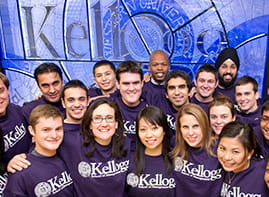3 takeaways from Marketing at the Leading Edge, the first dialogue in a series hosted by the Kellogg Marketing Department and Kellogg Marketing Club.
2/15/2017 - Some years back, a group at ConAgra noticed that consumption of Slim Jim meat snacks dropped precipitously between the core market of 13-17 year-olds and the next age group of 18-24 year-olds.
To connect with these older consumers—a distinct demographic—ConAgra released a decidedly edgy campaign. “I think we are the only company to run CPG spots with ‘yo momma’ and ‘that’s what she said’ jokes,” said Jill Dexter, the brand director for Slim Jim, while presenting at
a recent talk hosted by the Kellogg Marketing Club.
From her experience managing the Slim Jim campaign, Dexter offered insights into the tricky balance of marketing that pushes boundaries without being offensive. In his introduction to the talk, associate professor of marketing Kent Grayson noted that, “we have to be comfortable as marketers that some customers aren’t going to like us. Some might even hate us. But we don’t want to go out there and simply make people angry.”
Dexter offered three specific points for walking this tightrope—for getting attention while avoiding boycotts.
Keep the creatives on task
“You want people to laugh,” said Dexter, and creative teams are good at getting laughs. “But you need to keep reminding them that this is not only entertainment. We’re looking for results, for sales.”
Campaigns should develop and refer to a “playbook on the mandatories,” as Dexter put it. Certain actions must be included, or phrases used, or visuals present in order to reiterate a link to the brand. (In the case of Slim Jim: the signature snap when someone takes a bite, and the phrase “Snap into a Slim Jim.”) Slim Jim is also careful to create worlds within each advertisement that resonate with its audience, from the kind of dialog and wardrobe used to the diverse demographic profiles of actors. This taps into “latent equity with consumers,” said Dexter.
Derek Rucker, a professor of marketing at Kellogg, corroborated the importance of helping creative partners stay on task in a postscript to Dexter’s talk. Rucker says that the challenge with distinct ads is that they “can give rise to a bimodal distribution”: often highly distinct ads rank among the best, or among the worst. Why? “Distinct spots push boundaries, which can get brands in trouble,” he said, “a worse case scenario is that a brand must spend money to apologize for an ad.” This major failure tends to take place when ads go off-strategy—when they become disconnected from the brand. “Yes: make it distinct. Yes: make it break through. But be sure it is strategically sound,” Rucker said.
Manage organizational fear and listen to stakeholders
Behind every campaign is a group of stakeholders, and it’s critical that everybody is comfortable with a campaign. This often boils down to persuasion. “One key challenge,” said Dexter, “is making sure people whose job it is to say ‘no, we don’t want to take that risk,’ say ‘yes’.”
To get this ‘yes,’ brand directors first need to thoroughly and precisely outline the target consumer for other stakeholders. Though consumer profiles are often defined by hundreds of hours of research, highlight the essentials to help stakeholders understand who the consumers are. Using the consumer group’s own language, or ‘verbatims,’ can be a useful tool in this process. Once the audience has been defined, lay out the content distribution plan and the relevance of various touch-points, Dexter explained. Make sure all of this happens well in advance of launch, too. “Don’t come in and show a final spot and say we’re shooting in 48 hours. Make sure the stakeholders’ voices are heard, and adjust accordingly.”
Once a campaign is launched, consumers become a new stakeholder group, and they should be listened to as well. As a result of Slim Jim’s more controversial ads, Dexter has received pushback from plenty of viewers, including politicians. “Be ready for that,” she said.
Precisely match your ads with outlets
The vast array of distribution channels available—TV, digital, social media, mobile—allows for an unmatched level of consumer targeting. “Different channels enable different levels of execution for pushing boundaries,” Dexter said.
Slim Jim, for instance, uses ESPN to reach its broadest base and pushes edgier ads to more narrowly targeted channels where a single, specific consumer group constitutes the majority of the audience. Slim Jim can also place ads on the monitors at gas pumps—timely, given more than 50 percent of sales take place at convenience stores.
“It’s crazy today how microscopic and targeted you can get in your media buys,” said Dexter. Use this fact to craft audience-appropriate content.
The dialogue, the first in a series hosted by Kellogg’s Marketing Department, will continue on February 17 with a presentation by Kevin McTigue with faculty host Alex Chernev on “
Managing the Consumer Journey in the Digital Age.”






